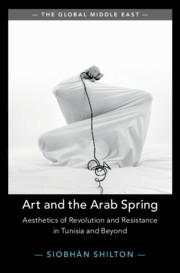Book contents
- Art and the Arab Spring
- The Global Middle East
- Art and the Arab Spring
- Copyright page
- Contents
- Figures
- Acknowledgements
- Introduction
- 1 Aesthetics of Revolution and Infra-thin Critique
- 2 Contingency and Resistance: Exceeding Icons through Matter and Motion
- 3 Contingent Encounters: Artists, Artisans and Amateurs
- 4 Corporeal Resistance and Aesthetics of the Interface
- Conclusion
- References
- Index
2 - Contingency and Resistance: Exceeding Icons through Matter and Motion
Published online by Cambridge University Press: 07 July 2021
- Art and the Arab Spring
- The Global Middle East
- Art and the Arab Spring
- Copyright page
- Contents
- Figures
- Acknowledgements
- Introduction
- 1 Aesthetics of Revolution and Infra-thin Critique
- 2 Contingency and Resistance: Exceeding Icons through Matter and Motion
- 3 Contingent Encounters: Artists, Artisans and Amateurs
- 4 Corporeal Resistance and Aesthetics of the Interface
- Conclusion
- References
- Index
Summary
In this chapter on Tunisia, I show how the dynamic between stability and instability, which encourages a more nuanced understanding of the revolution, is produced through ‘contingent encounters of resistance’. Contingency, I argue, comes to be associated with resistance through its convergence with icons. In the first part, I analyse works that incorporate contingent processes and materials (from bread to jasmine) in installations by Aïcha Filali, Nadia Kaabi-Linke and Lara Favaretto and in photographic series by Hela Lamine and Meriem Bouderbala. In the second part, I examine video work produced in the peripatetic mode: Mouna Karray’s Live (2012) projects static images of Ben Ali together with the unedited soundtrack of a conversation between a taxi driver and a passenger who comment freely on the transitional government as they journey through Tunis. I examine a precedent in Ismaïl Bahri’s Orientations (2010), which focuses on the evolving reflections in a cup of ink held by the artist as he walks within the streets of the capital. I consider how this work anticipates the more extreme limitations placed on vision in Bahri’s later videos. Comparative reference is made to works such as Azza Hamwi’s tour around Damascus in A Day and a Button.
Keywords
- Type
- Chapter
- Information
- Art and the Arab SpringAesthetics of Revolution and Resistance in Tunisia and Beyond, pp. 74 - 116Publisher: Cambridge University PressPrint publication year: 2021

